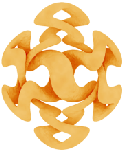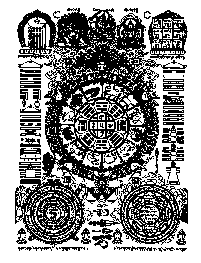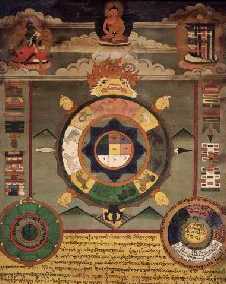
TIBETAN ASTROLOGY
Tibetan Astrology originated from
several different traditions: Indian, Chinese, the local Bon religion,
and the Buddhist Kalachakra tantra.
Traditionally, astrology was one of the five secondary sciences in Tibet. It concerns not only divination, but it is also used in the study of time cycles, Tibetan chronology and the compilation of the calendar. The calendar in the form of an almanac is still quite important in the daily life of the Tibetans to ensure that their daily activities are in tune with the cosmos. In general, certain days of the week and of the month are considered auspicious for specific activities (from marriage to hanging of prayer flags - even cutting one's hair); but also, every day relates to one's specific astrological chart of the day of birth. But also the position of the planets and the cycles of the elements determine good or bad fortune. In a Tibetan village, the astrologer would use
his skills to advise people about nearly everything: from the weather,
the best time to harvest, verify if and when two people should marry,
to important business deals. In case the outcome would be negative,
often religious practices would be advised to remove obstacles,
which would be carried out by monks of the local monastery. At the birth of a child, the charts would be checked to see if any special rituals were required to ward off negative planetary influences. Also a "death chart" would often be prepared to decide the exact performance of the funeral. Improper performance could result in problems for the family, as well as for the deceased. Tibetan astrology is not only strongly linked to religion, also Tibetan medical practitioners would study astrology (and religious texts) to determine the timing of medication etc. Tibetan 'Naktsi' astrology has mainly Chinese origins, and the 'Kartsi' astrology has Indian origins. TIBETAN 'NAMELESS RELIGION' ORIGIN From the ancient 'nameless religion' of Tibet, a system is preserved in current Tibetan astrology which relates to Five Individual Forces (La - vitality, Sok - life potential, Lu - bodily health, Wangthang - personal power, and Lungta - wind horse) or energies within a person. These energies relate to the Chinese animals and elements, for example, the La force of the Horse is Wood etc. This system is unique to Tibet and is important to establish yearly horoscopes. The La moves through the body in a monthly cycle, the Wangthang element is the same element that rules the year in Chinese astrology. When the forces become weak, numerous specific practices are prescribed to strengthen the force again, from saving lives of animals to reciting mantras or performing special rituals like exorcism.
BON ORIGINSThe Bon religion was well established in Tibet before the introduction of Buddhism. Over the centuries however, it appears that many Buddhist practices have taken root in Bon and reverse. For someone not too familiar with robes, iconography or rituals it may even be hard to spot the difference. Astrology is important within the Bon system. Methods are given for divination, warding off negative influences, astrological calculations and medical diagnosis. The four types of astrological calculation systems according to David Snellgrove are:
A very important Bon deity is called Balchen Geko, who is said to govern time and the three world of existence. In this respect the deity is analogous to Kalachakra in Buddhism. The Tibetan system works with a 360-day lunar year and cycles of 60 and 180 years. As a year is longer than 360 days, some days are doubled, and others are skipped. To make the calendar fit the observations, occasionally even an extra month is introduced. CHINESE ORIGINSFrom Chinese astronomy and astrology originate concepts like the Trigrams from the I Ching, the nine Magic Squares or Mewas, cycles of 12 and 60 years, the twelve Animals, the five elements and the duality of Yin and Yang etc. The traditional explanations say that princess Kongyo introduced Chinese astrology in Tibet in 643, but much earlier influences are very likely. Two main Tibetan systems are of Chinese origin: 'Naktsi' or 'black astrology' (referring to the Tibetan name for China: 'black area'), and the 'astrology of the elements' or Jungtsi. Five Elements Twelve Animals Each year is a combination of an animal and an element. This leads to cycles of 12 x 5 = 60 years. Nine Mewas The 'nine moles' or 'nine coloured islands' are derived from the I Ching and Chinese numerology. Each of the nine Mewas is related to a colour, a direction and an element. For example, the three whites (1, 6 and 8) are metal. Each day, month and year, the Mewas move. Eight Trigrams (Parkhas) These represent the equivalent of the Chinese pa-kua, which form the basis of the I Ching. In turn, the pa-kua are based on the concept of Yin and Yang. They are: Fire, Earth, Metal, Sky, Water, Mountain, Wood and Wind. They are an extension of the theory of the Five Elements INDIAN ORIGINSTibetan astrology may have been influenced by Indian sources as much as from Chinese. Analogous to above, India was known as the 'white area' and gave rise to the term 'white astrology'. Early Indian civilisation had much cultural interchange with the outside world, which is reflected in an identical zodiac to the Mesopotamians (twelve signs and twelve houses) and the widespread decans. Later on however, differences occurred for example when most other systems moved away from the early sidereal zodiac, which is preserved in the Indian tradition. Far back in history, also the Chinese and Indian system may have common origins. Similarities are for example the 28 Chinese lunar constellations and the 27 or 28 Indian Naksatras (from the Vedas), and the importance of the lunar nodes, Rahu and Ketu. Signs of the zodiac Lunar mansions
KALACHAKRAThe Kalachakra (Wheel of Time) tantric system contains
not only an extensive religious practice system, but also medical
knowledge. (See my site on Kalachakra.)
At the core of the system is the very familiar concept of 'as above,
so below', the correspondence of the outer universe with the inner
physical and mental processes in humans. It describes the interaction
of human and cosmic phenomena with time and builds a complete system
of Indian astrology. BUDDHISMOne could say that almost everything in Tibetan culture is strongly influenced by Buddhism. Even myths have been 'buddhified' over the ages. In Tibet, usually a teacher (lama), either monk or layman, would be the local astrologer. When living in a monastery, he would be responsible for establishing the calendar for religious practices and festivals. The following legend comes from 'Tibetan Astrology' by Philippe Cornu. It is based on the manifestation of a Buddha called Manjushri (see image), who is a personification of wisdom and insight. Tibetan teachers invoke Manjushri at the commencement of any astrological undertaking.
As Tibetan astrology is so directly related to religion, it is regarded as a practical method to reduce uncertainty and suffering. The correct motivation of an astrologer is compassion (wanting others to be free from suffering), and as such an astrologer is not different from a spiritual practitioner, a medical doctor or a Buddhist teacher. Tibetan calendar and astrology links Book references:
|



 Planets
Planets